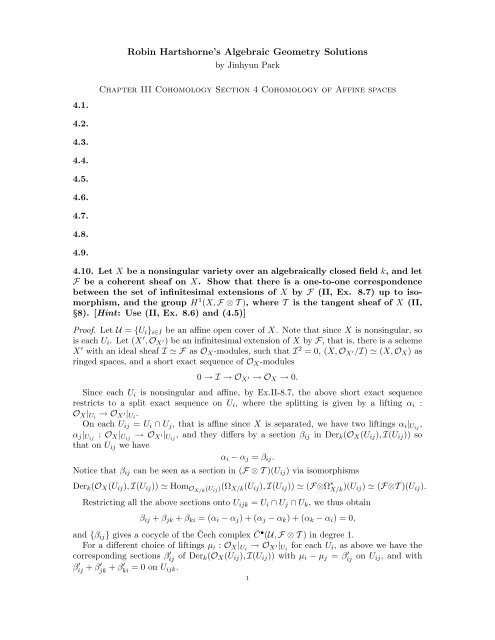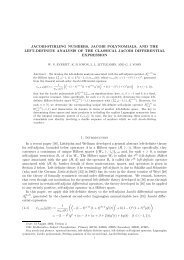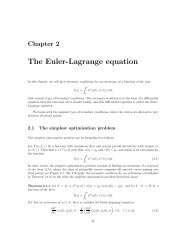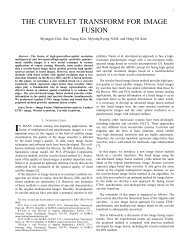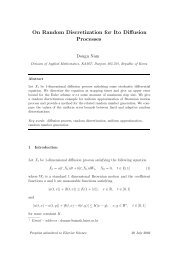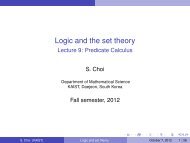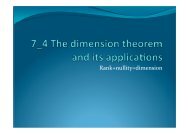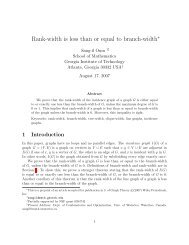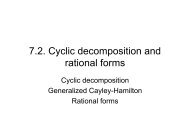Robin Hartshorne's Algebraic Geometry Solutions
Robin Hartshorne's Algebraic Geometry Solutions
Robin Hartshorne's Algebraic Geometry Solutions
Create successful ePaper yourself
Turn your PDF publications into a flip-book with our unique Google optimized e-Paper software.
<strong>Robin</strong> Hartshorne’s <strong>Algebraic</strong> <strong>Geometry</strong> <strong>Solutions</strong><br />
by Jinhyun Park<br />
Chapter III Cohomology Section 4 Cohomology of Affine spaces<br />
4.1.<br />
4.2.<br />
4.3.<br />
4.4.<br />
4.5.<br />
4.6.<br />
4.7.<br />
4.8.<br />
4.9.<br />
4.10. Let X be a nonsingular variety over an algebraically closed field k, and let<br />
F be a coherent sheaf on X. Show that there is a one-to-one correspondence<br />
between the set of infinitesimal extensions of X by F (II, Ex. 8.7) up to isomorphism,<br />
and the group H 1 (X, F ⊗ T ), where T is the tangent sheaf of X (II,<br />
§8). [Hint: Use (II, Ex. 8.6) and (4.5)]<br />
Proof. Let U = {U i } i∈I be an affine open cover of X. Note that since X is nonsingular, so<br />
is each U i . Let (X ′ , O X ′) be an infinitesimal extension of X by F, that is, there is a scheme<br />
X ′ with an ideal sheaf I ≃ F as O X -modules, such that I 2 = 0, (X, O X ′/I) ≃ (X, O X ) as<br />
ringed spaces, and a short exact sequence of O X -modules<br />
0 → I → O X ′ → O X → 0.<br />
Since each U i is nonsingular and affine, by Ex.II-8.7, the above short exact sequence<br />
restricts to a split exact sequence on U i , where the splitting is given by a lifting α i :<br />
O X | Ui → O X ′| Ui .<br />
On each U ij = U i ∩ U j , that is affine since X is separated, we have two liftings α i | Uij ,<br />
α j | Uij : O X | Uij → O X ′| Uij , and they differs by a section β ij in Der k (O X (U ij ), I(U ij )) so<br />
that on U ij we have<br />
α i − α j = β ij .<br />
Notice that β ij can be seen as a section in (F ⊗ T )(U ij ) via isomorphisms<br />
Der k (O X (U ij ), I(U ij )) ≃ Hom OX/k (U ij )(Ω X/k (U ij ), I(U ij )) ≃ (F⊗Ω ∗ X/k )(U ij) ≃ (F⊗T )(U ij ).<br />
Restricting all the above sections onto U ijk = U i ∩ U j ∩ U k , we thus obtain<br />
β ij + β jk + β ki = (α i − α j ) + (α j − α k ) + (α k − α i ) = 0,<br />
and {β ij } gives a cocycle of the Čech complex ˘C • (U, F ⊗ T ) in degree 1.<br />
For a different choice of liftings µ i : O X | Ui → O X ′| Ui for each U i , as above we have the<br />
corresponding sections β ′ ij of Der k(O X (U ij ), I(U ij )) with µ i − µ j = β ′ ij on U ij, and with<br />
β ′ ij + β′ jk + β′ ki = 0 on U ijk.<br />
1
2<br />
Applying the Ex. II-8.6- (a) again to the pair of liftings α i and µ i on U i , we have sections<br />
ξ i of Der k (O X (U i ), I(U i )) for each U i with α i − µ = ξ i , that can also be seen as a section of<br />
F ⊗ T on U i . Then, on U ij we have<br />
β ij − β ′ ij = (α i − α j ) − (µ i − µ j ) = ξ i − ξ j ,<br />
thus the cocycles {β ij } and {β ij ′ } give the same cohomology class in ˘H 1 (U, F ⊗ T ). This<br />
last group is isomorphic to H 1 (X, F ⊗ T ) by (4.5). The converse is easy. This finishes the<br />
proof.<br />
□<br />
4.11.


